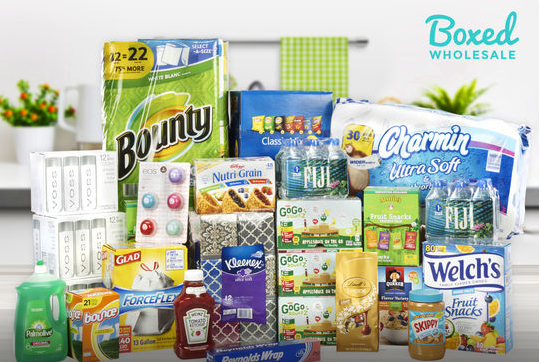

We all hear so much about the 800 pound gorilla in the industry which is Amazon and most recently, Jet. But there are other important players to understand and potentially do business with including Boxed, an online bulk goods retailer of everyday household essentials, which has raised a little under $150 million since launching 3 years ago.
In a transcript form the Profitero Podcast Series, Profitero’s SVP Strategy and Insights Keith Anderson speaks to Chieh Huang, co-founder and CEO of Boxed Wholesale.
Keith and Chieh discuss the economics behind the Boxed business model, where it fits in today’s ecosystem of increasingly diverse online models, the importance of mobile (Boxed first launched as mobile-only), as well as insight into how CPG brands can effectively partner with Boxed.
KA: Do you mind giving folks the elevator pitch on Boxed?
CH: Boxed is the wholesale club, aka Sam’s Club or Costco, for a younger generation that doesn’t have the physical means, aka a car, the time, or the patience, to access their local warehouse club. We’ve been in business about 3 years now. It’s been a fun journey from me and the co-founder standing in a cold garage in central New Jersey to now, where we have 6 locations across the US, and have raised a little under 150 million dollars to date.
What you find in the industry is that a lot of folks in pure play feel like pure play is the end all, be all. I think a lot of folks with just brick and mortar with a very light omni-channel presence think that brick and mortar will be the place where retail will be in 50 years. I think both those folks are probably wrong and it’s somewhere in the middle. Even though you have a car eventually in the future you might not have the time or the patience to go. In those instances Boxed would be a pretty good alternative.

KA: You and I were on stage at a Nielsen event together about 6 months ago. We were there with Jet and Instacart, and they’ve been some interesting developments in the market since then. I think what everybody is starting to acknowledge is that eCommerce for consumer package goods is going to happen. What would be helpful is to understand a little bit about where Boxed fits today, and potentially in the future, in this ecosystem of increasingly diverse online formats.
CH: I’m really glad that you brought that point up because everyone up until now has thought of pure play or thought of online as just being one model. You have to be the everything store, you have to have unlimited shelf. For the most part that has been a very successful model pioneered by Amazon, basically a sport that they invented. But as you see today with offline retail it would just be totally preposterous to think that there’s only one winning formula for offline retail. As more and more dollars get spent online over the next 10, 20, 30 years we’ll look back and think it was absolutely crazy to only think that one playbook won all of online retail. We’re starting to transition into that phase where so much money is spent online that different models can succeed.
So, your question about where we fit in, I would say let’s answer the question of what we are not. We are actually not the everything store. We’re limited assortment, a very curated selection of items based on where you are across the country, that gets to you in generally two days or less. From that perspective you would think of us as another entrant in the wholesale club model. Which is generally true, we have large format only SKUs and we regionally select what items are in the “club”.
Also, at the same time, we obviously deliver to you, we carry vastly different brands than what’s available in an in-store club. We’re evolving into a model in and of ourselves. In the future I would probably see Boxed as one of the entrants in the warehouse club space, but at the same time I would say we would be the most convenient warehouse club. That’s where we would solidify our space in the ecosystem.
KA: One thing that I think is noticeably distinct is the membership fee. A lot of people have written and talked about the importance of membership fees and membership revenue. What role do you think the fee plays for an online club like Boxed?
CH: Whether it’s us at Boxed or anyone, it’s just another lever to pull when you’re developing a model. On one hand, if you do one item per order as most online retailers do, you actually need to offset that loss you’re inevitably going to incur when you ship it across the country to someone’s doorstep. You can recoup that loss via one of several ways.
You can go to the manufacturer and have them subsidize. I’m sure some manufacturers are listening to the show, they’ll probably say they’ve gotten a few knocks on the door asking them to subsidize shipping costs on behalf of some of the retailers. The second part of that could be via membership fee.
Luckily because our model is completely different, because we are not the everything store, what we find is we’ve been able to generate the largest CPG only order, considering we don’t even carry fresh foods for the most of the country. Our average B to C ring is above a hundred dollars and 9.8 items per order.
When you find that you have a model like ours, where you’re shipping 9.8 items per person, you can effectively amortize the shipping cost over those 9.8 items. So, it’s not necessarily the case that you lose money on every box that you’re shipping out. To date, membership fees have not played a role in our model. Could it in the future? Absolutely. Is it necessary to? No, not for our model. Because of the abnormally high ring and items per order.
KA: Rather than trying to manage an endless aisle and deal with item level economics for tens or sometimes hundreds of items, how many items does the typical supplier have in distribution with Boxed? Or maybe another angle on it is, in a given category, how many items does Boxed typically carry?
CH: That’s actually one of the first times I’ve ever been asked that question. It’s an incredibly insightful question. When you find any given category we don’t have a hard and fast rule, but we rarely go beyond good, better, best. You’ll find very few categories where we have 4, 5, 10 entrants. Some items you’ll just find that folks really want their brand and they will not order anything unless you have their brand in this category. We’ll go a little deeper there, but for the most part you’re either just good, better, best.
Now, it’s a really great question as to what is the number of items that an average manufacturer has. It really depends on the level of cooperation. For us, ones that we have a great JPV (joint promotional value) cadence where we’re constantly sitting down and planning out our numbers and seeing what else they have, when we have a great relationship, you’ll find manufacturers with double digit items. I don’t think anyone has over a hundred items on our platform yet, but you’ll find us going pretty deep with that manufacturer. You’ll have other major manufacturers where we don’t have an incredible relationship with where they might have four, even though their portfolio includes hundreds of items. So, it really runs the gambit and it really depends. Partially because we’re so young as a business that even for us we’re still testing out how much our model can bear before people get fatigue and before people start searching for what they want, finding it, and checking out with a single item. Which is completely against our current model.
KA: Can you expand at all on the dynamic between your model that focuses on curation and essentially discovery as opposed to some of the more common, what are sometimes called spear-fishing, search-oriented models, where somebody is really focused on finding a specific product or maybe at least a specific brand? What’s distinct and different about the shoppers pathway to a given product on your site?

CH: The biggest point of differentiation is the vast majority of our customers do not use the search bar on their path to purchase. So, as they’re not using a search bar, what they’re doing is scrolling through the app, scrolling through the website, just like they would be pushing through unlabeled aisles in a warehouse club discovering items as they go along. What we find is that maybe they come in with intent to buy one or two items, but actually most of the items in their cart were not on their original list.
What you also find is that because we do not incentivize shoppers to add more to their cart, they naturally build a basket. Which to the listeners out there it’ll be really interesting because this is right back to what powered brands and their knowledge of how to power their business or grow their business. How customers are building their basket. That largely has gone away so it’s really interesting that that’s what we’re about and that provides some incredible insights back to how folks are building their baskets and what the hottest adjacent products are.
KA: You mentioned the app and the scrolling and I know that Boxed was born on mobile. Are there any lessons learned from optimizing for mobile-only? And first?
CH: Being mobile-only versus mobile-first is very different even as we’re living it day-to-day now. Being mobile-only means that almost all of your resources are going to the app. When you went to Boxed.com it was just a landing page. It just directed you to download the app. Now, obviously, we’re live on the web as well so you have to stack accordingly against it. Also, think about multi-screen carts and cart sharing. That’s been a really big difference in how we plan out product.
One unique challenge is that for folks to keep scrolling and not searching on a mobile app is actually very different from the experience you need to plan out when they’re on a desktop where muscle memory has trained them to go to the search bar over the last 16 years of shopping online. Very different approaches are taken when we look at mobile versus desktop.
KA: How should a brand think about getting started with Boxed? What’s the destination?
For one, is just to really think about us as a separate channel. Some of the least successful manufacturers are those with just regular retail packs or items that weren’t meant to be in a warehouse style environment. It may sound like, “Oh, I guess they gave it a try.” But it’s as crazy as in the offline world if you went and tried to sell the wholesale pack or went with the dollar store portfolio, the dollar channel portfolio to the drug portfolio or to a club.
Two, something else to keep in mind, when it comes to pure play and when it comes to the playground in which we offer manufacturers, the sky is the limit. You want to offer samples so we can feedback trial and repeat rates back to the brand managers? That’s very easy. Do you want to get something to market in a 90 days time frame instead of a year and a half time frame and test it out? That’s actually possible as well. Really thinking that it’s not just about stocking Boxed with your items and trying to dump the whole portfolio on us, but also thinking about what else you can do on Boxed is really key.
When it comes to destination, obviously there’s the website and you’ll find the supplier page on there, but at the end of the day I’m very accessible and we built out a very good merchant and buyer team here at Boxed. I can be easily reached at chieh@boxed.com. From there on out I’ll loop the appropriate buying team in.
The business has started to scale tremendously and we’ve also been able to hire some really awesome talent from across the industry, including our latest hire Heather Mayo who’s joining us from Sam’s Club as their former SVP of Ops. You’ll see some familiar faces around here. We’re happy and the doors are open for new suppliers to get into the mix.
To hear other industry thought leaders discuss the latest eCommerce trends impacting the CPG and retail sector today, listen to the Profitero Podcast Series.


























